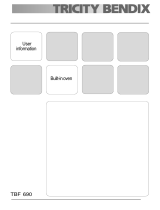
Fan Cooking
The air inside the oven is heated by the element around
the fan situated behind the back panel. The fan circulates
hot air to maintain an even temperature inside the oven.
The advantage of cooking with this function is energy
saving through:
• Faster Preheating
As the fan oven quickly reaches temperature, it is not
usually necessary to preheat the oven although you
may find that you need to allow an extra 5-7 minutes
on cooking times. For recipes which require higher
temperatures, best results are achieved if the oven is
preheated first, e.g. bread, pastries, scones, souffles,
etc.
• Lower Temperatures
Fan oven cooking generally requires lower tempera-
tures than conventional cooking. Follow the tempera-
tures recommended in the cooking chart. Remember
to reduce temperatures by about 20-25°C for your own
recipes which use conventional cooking.
• Even Heating for Baking
The fan oven has uniform heating on all shelf positions.
This means that batches of the same food can be
cooked in the oven at the same time. However, the top
shelf may brown slightly quicker than the lower one.
This is quite usual. There is no mixing of flavours be-
tween dishes.
– Shelf positions are not critical, but make sure the
shelves are evenly spaced.
– When cooking more than one dish in the fan oven,
place dishes centrally on the shelves rather than sev-
eral dishes on one shelf.
– When the oven is full, you may need to allow slightly
longer cooking time.
– When the oven is full of the same food, e.g. equal trays
of small cakes or equal size victoria sandwich cakes,
then they will be cooked in the same time and removed
from the oven together. When different sizes of trays
or types of food, e.g. biscuits and cakes are cooked,
they will not necessarily be ready together.
– The fan oven can be used to heat foods through without
thawing first, e.g. fruit tarts, mince pies, sausage rolls,
and other small pastry items. Use a temperature of
190-200°C and allow 20-40 minutes (depending on
the quantity of food in the oven).
– The use of too high temperatures can cause uneven
browning. Check with the recommendations for oven
temperatures given in the cooking charts, but be pre-
pared to adjust the temperature, if necessary. Remem-
ber to reduce temperatures by about 20-25°C for your
own conventional recipes.
– When roasting do use the trivet in the meat tin. Fat and
meat juices will drain into the meat tin below and can
be used to make gravy. The trivet also prevents
splashes of fat from soiling the oven interior.
– The meat tin should not be placed on a heated hotplate
as this may cause the enamel to crack.
How to use the Fan Oven
1.
Turn the oven function control knob to
.
2. Turn the thermostat control to the required tempera-
ture.
The oven light will come on when the oven function
control knob is set.
The oven fan will operate continually during cook-
ing.
The thermostat control light will remain on until the
correct temperature is reached. It will then cycle on
and off to show the temperature is being maintained.
The Cooling Fan
The cooling fan will operate continually during cooking.
It may run on after the oven is switched off to keep the
controls cool. This is quite normal.
Grilling -
– Most foods should be placed on the grid in the grill
pan to allow maximum circulation of air and to lift the
food out of the fats and juices. Food such as fish, liver
and kidneys may be placed directly on the grill pan, if
preferred.
– Food should be thoroughly dried before grilling to
minimise splashing. Brush lean meats and fish lightly
with a little oil or melted butter to keep them moist
during cooking.
– Accompaniments such as tomatoes and mushrooms
may be placed underneath the grid when grilling meats
– When toasting bread, we suggest that the top runner
position is used.
– The food should be turned over during cooking, as
required.
How to use the Full Grill Element
1.
Turn the oven control function knob on
.
9




















